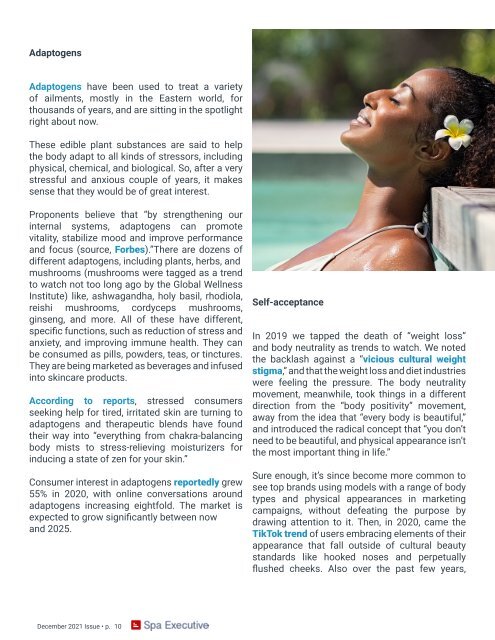Spa Executive - December 2021
Create successful ePaper yourself
Turn your PDF publications into a flip-book with our unique Google optimized e-Paper software.
Adaptogens<br />
Adaptogens have been used to treat a variety<br />
of ailments, mostly in the Eastern world, for<br />
thousands of years, and are sitting in the spotlight<br />
right about now.<br />
These edible plant substances are said to help<br />
the body adapt to all kinds of stressors, including<br />
physical, chemical, and biological. So, after a very<br />
stressful and anxious couple of years, it makes<br />
sense that they would be of great interest.<br />
Proponents believe that “by strengthening our<br />
internal systems, adaptogens can promote<br />
vitality, stabilize mood and improve performance<br />
and focus (source, Forbes).”There are dozens of<br />
different adaptogens, including plants, herbs, and<br />
mushrooms (mushrooms were tagged as a trend<br />
to watch not too long ago by the Global Wellness<br />
Institute) like, ashwagandha, holy basil, rhodiola,<br />
reishi mushrooms, cordyceps mushrooms,<br />
ginseng, and more. All of these have different,<br />
specific functions, such as reduction of stress and<br />
anxiety, and improving immune health. They can<br />
be consumed as pills, powders, teas, or tinctures.<br />
They are being marketed as beverages and infused<br />
into skincare products.<br />
According to reports, stressed consumers<br />
seeking help for tired, irritated skin are turning to<br />
adaptogens and therapeutic blends have found<br />
their way into “everything from chakra-balancing<br />
body mists to stress-relieving moisturizers for<br />
inducing a state of zen for your skin.”<br />
Consumer interest in adaptogens reportedly grew<br />
55% in 2020, with online conversations around<br />
adaptogens increasing eightfold. The market is<br />
expected to grow significantly between now<br />
and 2025.<br />
Self-acceptance<br />
In 2019 we tapped the death of “weight loss”<br />
and body neutrality as trends to watch. We noted<br />
the backlash against a “vicious cultural weight<br />
stigma,” and that the weight loss and diet industries<br />
were feeling the pressure. The body neutrality<br />
movement, meanwhile, took things in a different<br />
direction from the “body positivity” movement,<br />
away from the idea that “every body is beautiful,”<br />
and introduced the radical concept that “you don’t<br />
need to be beautiful, and physical appearance isn’t<br />
the most important thing in life.”<br />
Sure enough, it’s since become more common to<br />
see top brands using models with a range of body<br />
types and physical appearances in marketing<br />
campaigns, without defeating the purpose by<br />
drawing attention to it. Then, in 2020, came the<br />
TikTok trend of users embracing elements of their<br />
appearance that fall outside of cultural beauty<br />
standards like hooked noses and perpetually<br />
flushed cheeks. Also over the past few years,<br />
<strong>December</strong> <strong>2021</strong> Issue • p. 10


















